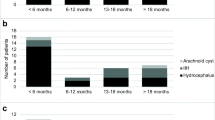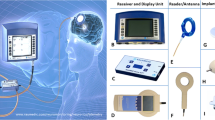Abstract
Background
Telemetric intracranial pressure (ICP) monitoring enable long-term ICP monitoring on patients during normal day activities and may accordingly be of use during evaluation and treatment of complicated ICP disorders. However, the benefits of such equipment depend strongly on the validity of the recordings and how often the telemetric sensor needs to be re-implanted. This study investigates the clinical and technical sensor survival time and drift of the telemetric ICP sensor: Raumedic Neurovent-P-tel.
Methods
Implanted telemetric ICP sensors in the period from January 2011 to December 2017 were identified, and medical records reviewed for complications, explantation reasons, and parameters relevant for determining clinical and technical sensor survival time. Explanted sensors were tested in an experimental setup to study baseline drift.
Results
In total, implantation of 119 sensors were identified. Five sensors (4.2%) were explanted due to skin damage, three (2.5%) due to wound infection, and two (1.7%) due to ethylene oxide allergy. No other complications were observed. The median clinical sensor survival time was 208 days (95% CI 150–382). The median technical sensor survival time was 556 days (95% CI 382–605). Explanted sensors had a median baseline drift of 2.5 mmHg (IQR 2.0–5.5).
Conclusion
In most cases, the ICP sensor provides reliable measurements beyond the approved implantation time of 90 days. Thus, the sensor should not be routinely removed after this period, if ICP monitoring is still indicated. However, some sensors showed technical malfunction prior to the CE-approval, underlining that caution should always be taken when analyzing telemetric ICP curves.





Similar content being viewed by others
References
Andresen M, Juhler M (2014) Intracranial pressure following complete removal of a small demarcated brain tumor: a model for normal intracranial pressure in humans. J Neurosurg 121(4):797–801
Antes S, Tschan CA, Kunze G, Ewert L, Zimmer A, Halfmann A, Oertel J (2014) Clinical and radiological findings in long-term intracranial pressure monitoring. Acta Neurochir 156(5):1009–1019
Antes S, Tschan CA, Heckelmann M, Breuskin D, Oertel J (2016) Telemetric intracranial pressure monitoring with the raumedic Neurovent P-tel. World Neurosurg 91:133–148
Barber JM, Pringle CJ, Raffalli-Ebezant H, Pathmanaban O, Ramirez R, Kamaly-Asl ID (2017) Telemetric intra-cranial pressure monitoring: clinical and financial considerations. Br J Neurosurg 31(3):300–306
Bousquet J, Michel FÇB (1991) Allergy to formaldehyde and ethylene-oxide. Clin Rev Allergy 9(3–4):357–370
Czosnyka Z, Czosnyka M (2017) Long-term monitoring of intracranial pressure in normal pressure hydrocephalus and other CSF disorders. Acta Neurochir 159(10):1979–1980
Czosnyka M, Pickard JD, Steiner LA (2017) Principles of intracranial pressure monitoring and treatment, 1st ed. Handb Clin Neurol. https://doi.org/10.1016/B978-0-444-63600-3.00005-2
Freimann FB, Sprung C, Chopra SS, Vajkoczy P, Wolf S (2013) Large-scale referencing of the telemetric Neurovent-P-tel intracranial pressure sensor in a porcine model. Pediatr Neurosurg 49(1):29–32
Fried HI, Nathan BR, Rowe AS, Zabramski JM, Andaluz N, Bhimraj A, Guanci MMK, Seder DB, Singh JM (2016) The insertion and management of external ventricular drains: an evidence-based consensus statement: a statement for healthcare professionals from the neurocritical care society. Neurocrit Care 24(1):61–81
Jiang G (2010) Design challenges of implantable pressure monitoring system. Front Neurosci 4(FEB):2–5
Kiefer M, Antes S, Leonhardt S, Schmitt M, Orakcioglu B, Sakowitz OW, Eymann R (2012) Telemetric ICP measurement with the first CE-approved device: data from animal experiments and initial clinical experiences. Acta Neurochir (Suppl):111–116
Kotzar G, Freas M, Abel P, Fleischman A, Roy S, Zorman C, Moran JM, Melzak J (2002) Evaluation of MEMS materials of construction for implantable medical devices. Biomaterials 23(13):2737–2750
Lilja A, Andresen M, Hadi A, Christoffersen D, Juhler M (2014) Clinical experience with telemetric intracranial pressure monitoring in a Danish neurosurgical center. Clin Neurol Neurosurg 120:36–40
Lilja-Cyron A, Kelsen J, Andresen M, Fugleholm K, Juhler M (2018) Feasibility of telemetric intracranial pressure monitoring in the neuro intensive care unit. J Neurotrauma 35(14):1578–1586
Lozier AP, Sciacca RR, Romagnoli MF, Connolly ES, McComb JG, Cohen AR, Rock JP (2002) Ventriculostomy-related infections: a critical review of the literature. Neurosurgery 51(1):170–182
Raboel PH, Bartek J, Andresen M, Bellander BM, Romner B (2012) Intracranial pressure monitoring: invasive versus non-invasive methods-a review. Crit Care Res Pract 2012:3–7
Sæhle T, Eide PK (2015) Intracranial pressure monitoring in pediatric and adult patients with hydrocephalus and tentative shunt failure: a single-center experience over 10 years in 146 patients. J Neurosurg 122(5):1076–1086
Schuhmann MU, Sood S, McAllister JP, Jaeger M, Ham SD, Czosnyka Z, Czosnyka M (2008) Value of overnight monitoring of intracranial pressure in hydrocephalic children. Pediatr Neurosurg 44(4):269–279
Welschehold S, Schmalhausen E, Dodier P, Vulcu S, Oertel J, Wagner W, Tschan CA (2012) First clinical results with a new telemetric intracranial pressure-monitoring system. Oper Neurosurg 70(1):44–49
Wiegand C, Richards P (2007) Measurement of intracranial pressure in children: a critical review of current methods. Dev Med Child Neurol 49(12):935–941
Yu L, Kim BJ, Meng E (2014) Chronically implanted pressure sensors: challenges and state of the field. Sensors (Switzerland) 14(11):20620–20644
Zacchetti L, Magnoni S, Di Corte F, Zanier ER, Stocchetti N (2015) Accuracy of intracranial pressure monitoring: systematic review and meta-analysis. Crit Care 19(1):1–8
Zhang X, Medow JE, Iskandar BJ, Wang F, Shokoueinejad M, Koueik J, Webster JG (2017) Invasive and noninvasive means of measuring intracranial pressure: a review. Physiol Meas 38(8):R143–R182
Zhong J, Dujovny M, Park HK, Perez E, Perlin AR, Diaz FG (2003) Advances in ICP monitoring techniques. Neurol Res 25(4):339–350
Acknowledgements
The authors are grateful for critical feedback from Torben Skovbo Hansen.
Funding
Financial support was received by the Lundbeck Foundation. The grant was given to Nicolas Hernandez Norager and included salary.
Author information
Authors and Affiliations
Corresponding author
Ethics declarations
Conflict of interest
The authors declare that they have no conflict of interest.
Ethical approval
The project was approved by the Data Protection Agency (journal number 2012-58-004). No ethics committee approval was needed, since the study is retrospective without patient identifiable data.
Consent
For this type of study, formal consent was not required.
Additional information
This article is part of the Topical Collection on Neurosurgical technique evaluation
Rights and permissions
About this article
Cite this article
Norager, N.H., Lilja-Cyron, A., Bjarkam, C.R. et al. Telemetry in intracranial pressure monitoring: sensor survival and drift. Acta Neurochir 160, 2137–2144 (2018). https://doi.org/10.1007/s00701-018-3691-9
Received:
Accepted:
Published:
Issue Date:
DOI: https://doi.org/10.1007/s00701-018-3691-9




